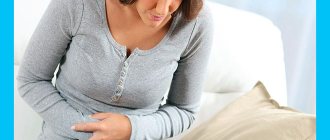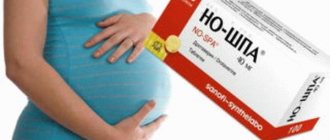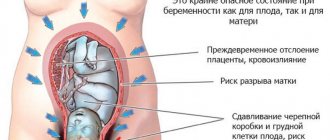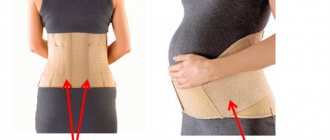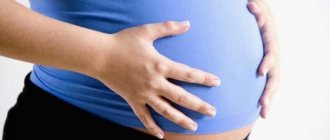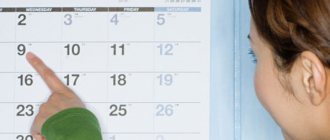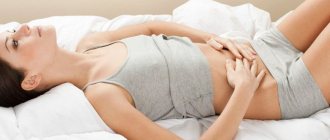A new life for a mother, which begins with the onset of pregnancy and the birth of a child, is not only accompanied by many joyful events, but also presents from time to time unpleasant postpartum pain. This is nature, you can’t argue with that. It is important that the young mother knows about this and carefully monitors her health, without exposing herself and the baby to additional stress.
The postpartum period is often no less difficult than pregnancy: pain may begin in the perineum, lower abdomen or lower back. This is a normal process of recovery of the body, the return of all organs to their previous state, and after about two months all processes should return to normal. If this does not happen, then you will need medical consultation.
What to do if you have pain in the lower abdomen after childbirth
The very first thing a woman experiencing severe pain should do is not endure it heroically, but consult a doctor to find out the cause and, depending on the diagnosis, wait patiently for complete healing of the organs or begin treatment. A clear indicator of the pathology of the postpartum period is an increase in temperature along with abdominal pain. This is a sign of infection, and there can be no talk of other options other than medical help.
If the pain is episodic in nature, that is, similar to contractions, but does not bring lingering pain, then this is a clear sign of uterine contraction. In this case, you can be patient.
As for nutrition, it is necessary to rationally organize your diet, this is especially important for mothers who are breastfeeding. Everything that the mother consumes enters the child’s body with her milk and has a great influence on the functioning of her own digestive tract, so you need to exclude spicy, salty, fatty foods from the diet, and consume more foods rich in calcium and vitamins.
If gas accumulates, you can gently massage the intestinal area.
In order to avoid excessive filling of the bladder, it is necessary to empty it regularly after a certain time, even if there is no obvious desire to go to the toilet.
To organize the recovery process after childbirth more productively, doctors recommend that mothers set aside a few minutes a day for gymnastics. A few simple exercises recommended by your doctor will help you quickly strengthen weakened muscles and the body as a whole.
The need for treatment of postpartum pain
Naturally, any woman will be disturbed and nervous by the pain of the postpartum period, and her first desire will be to get rid of them as quickly as possible. The fact is that it is impossible to independently determine the cause of pain symptoms, therefore, the main thing you need to learn is to under no circumstances undertake any self-medication methods. Each case is individual and depends on many factors:
- From how the birth proceeded;
- From the physiological structure of the body;
- From food.
The task of the young mother in this case is to control pain. If they become protracted and cause suffering, consult a doctor without delay.
Very often, after childbirth, women complain of severe pain of various types. Many women in labor experience a headache, which is caused by improper breathing during contractions and normally goes away within a few days after childbirth. Often, young mothers complain of chest pain due to the flow of milk and hardening in the mammary glands. In this case, doctors advise them to purchase a breast pump and constantly express the remaining milk after each feeding.
Also, unpleasant pain after childbirth can occur in some parts of a woman’s musculoskeletal system - in the neck, spine and muscles. In its intensity, childbirth can be compared to intense sports training. And for an unprepared body such a load can be excessive. This may well lead to a feeling of stiffness in the neck and shoulders. Stretching of the spinal muscles during childbirth leads to lower back pain, which can spread to the legs. Your hands may also hurt a little, but not because of a difficult birth, but because the woman is forced to constantly carry her newborn baby in her arms.
But the most severe pain after childbirth usually occurs at the sutures, in the lower abdomen and back.
Pain in the sutures torments not only those mothers who gave birth by cesarean section, but also those women who developed ruptures during childbirth. The stitches should heal within a few weeks after delivery. And all this time they need to be properly handled, avoiding contamination, getting wet, and heavy load on them. You cannot sit on the seams suddenly, but it is better to generally adapt to sitting down reclining.
If your stitches hurt a lot after childbirth, you can take painkillers. But it is important, together with your doctor, to choose a drug that is safe for breastfeeding. Try to move more. You will feel some discomfort in the stitches, but this will prevent you from experiencing really bad pain. If you notice swelling of the suture or bleeding, contact your doctor immediately.
Thirty-ninth week of pregnancy
The long-awaited week of pregnancy has arrived and your baby continues to grow.
At this time, the baby’s lungs are ready to breathe the first air, but for now he continues to be nourished thanks to the umbilical cord and placenta. Air and nutrients are supplied through a vein and two arteries in the umbilical cord. It is for this reason that after birth it is not cut immediately, but only when the pulsation in it stops.
The baby felt very cramped, given his height, which is about 50 cm. Normal weight is also considerable and varies from 3 to 3.5 kg. The subcutaneous tissue of the baby is sufficiently developed, and the skin has acquired a pale pink tint.
The cells of the spinal cord are well developed, but the full development of the central nervous system will take place after the baby is born. The child’s intestines already have villi that move food along, and the stomach produces all the necessary enzymes. The bacteria that are required for the complete absorption of food still come from the mother’s body.
The baby's first stool, called meconium, may pass into the amniotic fluid. In this case, doctors clean the baby’s bronchi. But in most cases, the original feces are released after the baby is born.
Feel
Preparing for childbirth never leaves my mind. The woman collects her things and thinks over and discusses with the gynecologist dozens of times all the details of the contractions and methods that will make childbirth easier.
Childbirth has not yet arrived, and there is no hurry, because not a single woman has remained pregnant for her entire life. At week 39, pregnancy does not fall into the post-term category. Therefore, the main thing is not to be nervous. Each pregnancy is individual.
Let's note the signs of post-term pregnancy:
- Reduced amount of amniotic fluid;
- Turbidity of amniotic fluid;
- Aging of the placenta;
- Reduced amount of frontal water or its complete absence;
- Lack of lubrication.
All this is typical for the period after 40 weeks, when labor is stimulated by various methods, which include: caesarean section and the administration of necessary drugs.
Such methods are caused by cessation of fetal growth or serious diseases of the pregnant woman, among which the leaders are diabetes and hypertension.
In this case, there is no need to worry, since doctors control the process.
If necessary, additional tests and ultrasound are prescribed. For now, it’s too early to think about it and let’s consider the condition of the stomach.
Stomach
The condition of the abdomen after 38 weeks of pregnancy depends on the individual characteristics of the body. For some women, it drops a few weeks before giving birth, for others, just before the baby is born.
During the day, the mother feels about 20 movements of the baby, which are distinguished by light but distinct pressure. This indicates that he is ready to go out into the world. The fundus of the uterus is already tilted slightly forward, and the tone of the abdominal muscles drops significantly. The baby's head, if the body position is correct, gradually moves towards the pelvis.
This week my skin has been stretched to its limit. Pigment spots have appeared, and many mothers begin to worry about itchy skin.
These are temporary symptoms that will disappear on their own after two weeks. The belly is very big. The baby is not as active as before, but his movements are felt more clearly.
Often the abdomen becomes very hard, especially in the case of false contractions. This is a natural process during which the uterus begins to exercise. To relieve tension, you need peace and complete relaxation.
If we are talking about a second pregnancy, then the symptoms are no different from the first birth and it is a little easier for the mother to navigate the warning signs of birth. Moreover, the body already has experience and you just need to rely on it.
Discharge
Natural discharge at 39 weeks of pregnancy includes the appearance of colostrum. The breasts swell and this is quite normal.
The main thing is to maintain hygiene and protect the glands from injury and hypothermia, although this applies to the body.
Throughout pregnancy, the cervix is closed by a plug, which is a mucous mass. The plug may begin to come off even before 39 weeks. A viscous mucus of a cream, white or yellow hue is released. If there are minor blood streaks, this is also not a cause for concern.
The plug peels off gradually and this process does not indicate that labor will begin. In this case, a visit to the hospital is not necessary, although it is necessary to inform the gynecologist about this.
The removal of the plug means that the uterus no longer has reliable protection against bacteria and infections, and therefore you will have to stop swimming in ponds and rivers. Also at this time it is better to exclude sexual activity.
If heavy bleeding begins to appear, this indicates that labor may begin within a few hours. Bleeding will indicate premature placental abruption. In both cases, you should go to the hospital immediately.
Another type of discharge, in which clear liquid flows out, indicates the departure of amniotic fluid. They have been leaking for some time now.
The bubble bursts instantly and the liquid comes out immediately. Such a harbinger of labor is immediately visible. There is no pain. You can’t wait until contractions start; you need to go to the hospital immediately.
Quite often the water does not drain and no leakage is observed. This is quite normal and does not cause any concern, especially since piercing the bladder is a simple and painless procedure.
Immediately before giving birth, women may notice the following signs:
- Increased appetite;
- Weight reduction;
- Removal of the protective plug and bloody discharge;
- The occurrence of loose stools;
- The emergence of the “nesting” instinct.
The main thing is support! At week 39, the expectant mother most of all needs the support of all loved ones. They are the ones who can replace all medications and the best gynecologists.
But not only the mother needs support, but also the little one. He is already ready to come into the world of people and he needs help with this. So talk to him and everything will be fine!
Source: https://moeditya.com/pregnancy/39-nedelya-beremennosti
Abdominal pain after childbirth
Abdominal pain also brings a lot of discomfort to a woman. They are completely natural, since the genitals return to normal after the child passes through the birth canal. Stretched and damaged internal tissues heal, microcracks formed in them are healed. And during the first week after giving birth, my stomach feels very tight.
The stomach also hurts after childbirth for another reason - under the influence of the hormone oxytocin, the uterus begins to actively contract, causing sensations similar to contractions. Abdominal pain worsens during breastfeeding, when oxytocin is most actively produced. But such pain also goes away within 1-2 weeks. And the more often you put your baby to your breast, the faster everything will pass.
In some cases, after childbirth, scraping of the placenta remains from the uterus is required. Doctors may notice this immediately after birth or a few days later with an ultrasound. Curettage is a rather painful procedure and is subsequently accompanied by prolonged pain in the uterine area.
Sometimes the cause of abdominal pain is endometritis. This is an inflammation in the uterus that occurs due to the entry of bacteria, viruses or fungi into it during a difficult birth or cesarean section (also very common during abortion). In addition to abdominal pain, endometritis is accompanied by an increase in temperature, as well as bloody discharge in a woman. Treatment should be started as soon as possible.
And it also happens that the cause of abdominal pain is problems with the gastrointestinal tract or, for example, constipation. And in this case, to get rid of pain, a woman only needs to adjust her diet.
But it is often difficult to independently determine the cause of pain. Therefore, it is best to consult a doctor who can diagnose and prescribe the correct treatment.
Another problem that plagues young mothers is back pain after childbirth. The lower back, neck and shoulders hurt, and there can be many reasons for this. Stress during childbirth and daily carrying of a child in your arms are only a small part of the possible causes.
During the birth of a child, a woman's pelvic muscles are greatly stretched to allow the baby's large head and body to pass through. Also, during childbirth, a woman may experience birth injuries - displacement of the hip joints or vertebrae of the sacral and lumbar regions. It is especially difficult for women in labor who are overweight, women with spinal curvature, and those who lack physical fitness.
In order to avoid such problems, doctors advise pregnant women to attend preparatory courses, where they will be taught how to breathe correctly and take the safest positions during labor. In addition, doctors recommend that women in labor refuse strong anesthesia, which does not allow the woman to control the birth process. When there is a strong load on the joints, the woman in labor feels increased pain and automatically changes position to ease the load. If anesthesia completely relieves pain, then the woman may not feel the displacement of the joints. And having painlessly survived several hours of labor, she begins to suffer from severe daily pain in the hips and lower back, which only goes away within a year. And in case of severe birth trauma, even surgical intervention may be required. But most often they use physiotherapy, exercise therapy and massage. The choice of drugs during lactation is very limited, so choosing a pain reliever is extremely difficult.
Another common cause of abdominal pain after childbirth is stretching of the abdominal muscles and contraction of the back muscles during pregnancy. Such pain tends to persist in the postpartum period, reminding itself during moments of squatting, bending and lifting heavy objects.
Whatever the causes of pain after childbirth, women should remember that during the postpartum period it is very important to limit their activity, not engage in heavy labor and simply take care of themselves. Pay attention to your health so that your body’s recovery is quick and painless.
Abdominal pain after childbirth is a process that every woman goes through. For a long time your muscles were in incredible tension, you were freed from the child. After childbirth, the pain lasts for several days.
Your body returns to normal, your muscles rest. Another reason after childbirth may be an episiotomy, after which the stitches hurt for quite a long time.
Etiology of physiological pain
The painful condition is characteristic of premenstrual syndrome. Abdominal pain sometimes occurs during ovulation. In women who have not given birth, pain occurs before the onset of menstruation; in women who have given birth, pain occurs after it. The reasons lie in excessive stretching of the walls of the uterus and arise as a consequence of past illnesses.
Help is to take painkillers. Colic can be quite severe; it is necessary to exclude peritonitis of the abdominal organs.
Read more Ovarian inflammation symptoms treatment at home
Pregnancy and painful sensations are a physiological condition for a woman and it is associated with the fact that the growing uterus puts more and more pressure on neighboring organs - the intestines, kidneys, and bladder. Acute pain radiating to the lower back and lower back in the first trimester indicates an unfavorable course of pregnancy.
If paroxysmal colic appears in the lower abdomen, you should immediately seek help. These are dangerous symptoms; there is a threat of miscarriage or spontaneous abortion.
The physiological category includes pain that occurs due to excessive tension in the abdominal muscles or sprain of the ligaments that hold the uterus in a certain position.
After childbirth, an inflammatory process sometimes occurs in the uterus due to the penetration of microbes. The temperature may rise, and purulent vaginal discharge may occur. Therefore, after childbirth, it is mandatory to inspect the uterus for possible remnants of the placenta and blood clots.
The recovery period after childbirth for women does not always go smoothly. The body needs some time to recover from such “stress”. After childbirth, contraction of the uterus causes pain. Severe cramping pain after childbirth is associated with stimulation by the child of the nipple during breastfeeding. The pain also increases due to pressure from nearby organs, for example, a full bladder.
Aches and pains after childbirth as a result of a caesarean section are understandable. The cause of this pain after childbirth is the presence of clots in the uterus or injury to the pubic bone. If the symptoms increase, the temperature rises, the woman requires immediate consultation and help from a doctor.
Lower abdomen hurts after childbirth
When breastfeeding, the body produces a hormone that causes the uterus to contract. After childbirth, this always causes slight pain. In order to get rid of unpleasant pain in the lower abdomen as quickly as possible, you should put your baby to the breast more often. Most pain is natural, but there are cases when the help of a doctor cannot be avoided. Endometritis is an inflammation of the lining of the uterus. If during childbirth an infection and microbes - fungi and bacteria - enter the uterus, the mucous membrane becomes inflamed and pain begins.
Most often this happens when. The symptomatic picture is as follows: pain in the lower abdomen, fever, bloody discharge with pus. Pain may be caused by the curettage procedure. If, when examining the uterus on the third day after birth, particles of placenta are found there, it is necessary to carry out this procedure to avoid purulent processes.
In some women giving birth, gastrointestinal diseases begin to worsen after childbirth. These pains radiate to the lower abdomen. A common occurrence after childbirth is a change in taste for food, and a new way of eating can also temporarily cause abdominal pain. Changing food can lead to constipation, which causes pain in the intestines.
The most common pain is in the lower abdomen after a caesarean section. And this is not surprising, since the woman had surgically cut the tissue in her peritoneum.
Another cause of pain in the lower abdomen is excessive accumulation of gases. Gases were unable to leave the intestines in time due to surgical intervention. They begin to distend the abdomen and at the same time cause quite painful sensations.
If the pain lasts no more than 2-5 days and is not too severe, there is no cause for concern. Remember that when carrying a child, the uterus increases significantly in size. After the baby is delivered, the muscles of the uterus begin intense contraction to return to its previous shape.
Such muscle work cannot take place without pain. A full bladder can also cause pain. Therefore, it is necessary to carefully ensure that the woman urinates as quickly as possible after childbirth. If she cannot do this herself, a catheter is inserted into her.
The pain may intensify when sneezing, coughing, or lifting even small weights. The frequency and duration of these abdominal pains depends on how easy or difficult the birth was. The body has come a long way, and its recovery is always accompanied by pain in the body, especially in the abdomen, where the child was and how he came out.
Postpartum inflammation of the appendages - or adnexitis. At first, the pain is slight, nagging, and the woman does not pay any attention to it. But if after a short period of time the pain does not go away, but begins to intensify, you should immediately contact a specialist. Infection during childbirth, both natural and cesarean section, can cause peritonitis. It is characterized by very severe pain in the lower abdomen, an increase in temperature is observed, and touching the places that hurt causes even greater pain.
During pregnancy, the pelvic bones begin to expand to allow the baby to pass through the pelvis successfully. After childbirth, they begin to return to their usual position. This is accompanied by a large flow of blood. This procedure for restoring the body is always accompanied by slight aching pain. Pain can also occur due to injury to the pubic cartilage during childbirth.
If after childbirth a woman experiences a lot of pain that radiates to the spine. This may indicate injury to some vertebrae during childbirth. In this case, you should immediately consult a doctor.
After childbirth, a woman may develop. It occurs when the placenta has not been completely removed. The remains of the placenta settle on the walls of the uterus, provoking the formation of blood clots. The uterus tries in every possible way to get rid of these elements. It begins to contract, and pain occurs that the woman feels in the lower abdomen. The pain intensifies and does not go away over a long period of time. In such cases, urgent consultation with a doctor is necessary to prevent suppuration in the uterus.
Pain after childbirth is natural. But if they still torment you and you do not want to endure them, it is worth carrying out a special set of physical exercises that will help tone your muscles and restore your body as quickly as possible. It is especially important to monitor your diet after childbirth and eat healthy foods. When there is an accumulation of gases, it is useful to massage using circular movements over the abdomen. Then no pain will torment you for a long time.
Throughout the entire period of bearing a child, the female body adapted to changing conditions. The uterus enlarged as the fetus grew, the location of the internal organs changed, and the blood vessels and nerve plexuses were compressed.
Childbirth is a sudden loss of 4-5 kg, and sometimes much more weight, as well as a decrease in abdominal volume. The organs must return to their original state, so it can be accepted as normal that the lower abdomen hurts after childbirth. In most cases, this is an indicator of the physiological course of the postpartum period.
Prevention
In order to prevent colitis, both acute and chronic, it is necessary to visit specialists on time and regularly for preventive examinations. Treat intestinal infections and intestinal diseases, helminthic infestations in a timely manner.
It is necessary to always and strictly adhere to the rules of a rational and healthy diet, which is especially important for chronic colitis. Strict adherence to the diet will allow you to achieve long-term remission.
Throughout the entire period of bearing a child, the female body adapted to changing conditions. The uterus enlarged as the fetus grew, the location of the internal organs changed, and the blood vessels and nerve plexuses were compressed.
Childbirth is a sudden loss of 4-5 kg, and sometimes much more weight, as well as a decrease in abdominal volume. The organs must return to their original state, so it can be accepted as normal that the lower abdomen hurts after childbirth. In most cases, this is an indicator of the physiological course of the postpartum period.
Read more Bruises began to appear on my legs
When is this considered normal?
Throughout pregnancy, the main hormone of the female body was. It reduced the tone of the uterus until the moment of birth and suppressed the secretion of prolactin. But by the day of delivery, its concentration decreased, but active production of oxytocin and prolactin began. Oxytocin controls the contractility of the smooth muscles of the uterus, but it is also necessary in the postpartum period, as well as throughout lactation.
Contractions of the uterine muscles are necessary during childbirth not only to open the cervix and expel the fetus. After separation of the placenta, the uterine walls are a continuous wound surface with bleeding vessels. For hemostasis, only activation of the coagulation system is not enough. A spasm of blood vessels and a decrease in their lumen should occur. Oxytocin ensures further contraction of the uterus after the birth of the child, allowing bleeding to stop.
The size of the uterus decreases very quickly in the postpartum period. The doctor evaluates them daily during a walk around the height of the day. The following are considered normal rates of reduction:
- immediately after birth - 4 cm above the navel (or 20 weeks of pregnancy);
- the end of the first day - at the level of the navel;
- on the second day - one finger width below the navel;
- on the 3rd day – 2 fingers below the navel;
- 4 days – in the middle of the distance between the pubic symphysis and the navel;
- on the 6th day – up to 9 cm above the pubis;
- on the 10th day – protrudes slightly above the womb;
- by 6-8 weeks corresponds to the state before pregnancy.
They are very painful, but postpartum contractions cannot be called pleasant. Most often they are associated with breastfeeding.
Two hormones are involved in the mechanism of milk formation and secretion. Prolactin ensures milk synthesis in the alveoli. Its excretion is regulated by oxytocin. When a baby is put to the breast, nipple irritation occurs, which stimulates the release of oxytocin by the pituitary gland. The hormone affects not only the myocytes of the mammary gland, its stimulating effect also extends to the myometrium. In the first few days, with each breastfeeding, a woman experiences cramping pain that resembles that during childbirth.
How long does your stomach hurt after childbirth?
This is a physiological process, it depends on the individual characteristics and speed of uterine contraction. In most cases, after 2 months the discomfort stops.
Also, do not forget about those who gave birth via cesarean section. In this case, physiological pain in the lower abdomen will be a natural reaction to a violation of the integrity of the anterior abdominal wall. The pain is post-operative. But it doesn't last long. In a hospital setting, narcotic analgesics are used to relieve pain, because they have a more pronounced analgesic effect. After about two days, you can switch to pain relief with an analgin solution, which in small doses will be safe for the child.
Signs of a pathological process
If after childbirth the stomach hurts for a natural reason, this condition is not characterized by additional symptoms. In the presence of a pathological process, pain can have a different nature and be accompanied by changes in the general condition.
Endometritis
During the first day, discharge from the genital tract should become brown, mucous, and less and less reminiscent of blood. But sometimes the bleeding does not decrease, but suddenly increases. At the same time, nagging pain appears in the lower abdomen. Additional signs are the following:
- temperature increase;
- signs of intoxication;
- purulent discharge from the genital tract;
- signs of uterine subinvolution;
- tachycardia.
These symptoms are characteristic of postpartum endometritis. The condition most often develops after a cesarean section, but can also occur as a result of natural childbirth. Endometritis is an infectious postpartum complication and requires immediate medical attention.
The cause is a violation of contractility, which is associated with retention of parts of the placenta or fetal membranes. While they are in the uterus, it is not able to contract normally, which means the pathological process will progress.
Endometritis threatens to turn into parametritis - inflammation of the periuterine tissue, pelvioperitonitis - damage to the pelvic part of the peritoneum, peritonitis - an infectious-inflammatory process in the abdominal cavity. In this case, abdominal pain will only increase.
Symphysitis
In some cases, only a radiologist together with a traumatologist can determine why the lower abdomen continues to hurt even in the long term after childbirth. The cause is often symphysitis - separation of the bones of the pubic symphysis.
The prerequisites for the appearance of this pathology are associated with physiological reasons. The same progesterone is to blame, as well as the hormone relaxin secreted by the placenta. It leads to softening and divergence of the symphysis pubis. This is necessary so that the birth canal can adapt as much as possible to the parameters of the fetus.
Normally, the distance between the two bones of this joint does not exceed 1 cm. The symphysis pubis is a semi-movable joint. This means that a minimum amount of displacement of its surfaces relative to each other is allowed. During the birth of a child, the joint may diverge by an additional 5-6 mm. But sometimes pathological processes come into play, then the displacement reaches a critical value and leads to pain localized in the lower abdomen.
Degrees of discrepancy:
- 1st degree – discrepancy 5-9 mm;
- 2nd degree – 10-20 mm;
- Grade 3 – more than 20 mm.
Postpartum pain caused by symphysitis most often appears 2-3 days after birth. A woman lying in bed cannot lift her legs up; walking causes pain. An accurate diagnosis can be made only after X-ray diagnostics.
Constipation
Postpartum abdominal pain may be associated with a more common cause. The intestines do not always quickly return to normal after pregnancy and childbirth. Sometimes it takes a while to get it going. But all this time, feces will accumulate, expanding the sigmoid colon and rectal ampulla. This is accompanied by a nagging, aching, bursting pain in the abdomen, which manifests itself approximately a week after delivery. If measures are not taken in a timely manner, constipation will become extreme.
For some women after childbirth, going to the toilet is associated with a certain fear of damaging the existing sutures on the perineum or hemorrhoids. At the same time, stagnant processes in the intestines are aggravated: liquid from the stool is gradually absorbed back into the intestines, it becomes dry and can lead to greater damage to the lower part of the intestines.
The presence of stool disorders harms not only the digestive tract. This causes displacement or compression of the uterus, and can lead to subinvolution.
Placental polyp
Retention of parts of the placenta in the uterine cavity will most likely lead to bleeding in the early postpartum period. But sometimes small parts, microscopic chorionic villi allow the uterus to fully contract, and signs of pathology appear after a long time.
The clinical picture appears after 4-5 weeks. Pain in the lower abdomen is not a characteristic sign of pathology; bleeding comes first, resulting in a decrease in hemoglobin, weakness, dizziness, and tachycardia. Uterine pain after childbirth appears after infection and the development of endometritis. Further, the clinical picture will develop according to the classic pattern of uterine inflammation.
Osteochondrosis
During pregnancy, a woman's posture changes. This is due to weight gain and its redistribution to the abdominal area. If the pregnant woman did not use a special support bandage, the pain syndrome will be severe.
After delivery, not everything immediately falls into place. Sometimes during pregnancy, compression of the nerve plexuses occurs, and after childbirth this can manifest itself as signs of osteochondrosis or neuritis. Pain in the lower abdomen will be combined with irradiation into the abdominal cavity.
When to see a doctor
The duration of the period of pain depends on individual characteristics and the speed of uterine involution. In most cases, during the first two weeks, the physiological discomfort associated with feeding the baby gradually decreases. The pain no longer appears at every feeding; its intensity decreases. When the uterus contracts completely, this symptom will disappear.
But there are signs that indicate a possible pathological process. If they appear, do not delay your visit to the doctor:
- temperature may be low at first and then rise to 39°C;
- disturbance of general well-being - weakness that does not go away after rest;
- nagging pain in the lower abdomen that is constantly present;
- chills as a symptom of fever;
- headache;
- bloody discharge from the genital tract (it may intensify and change in character from mucous to more liquid, reminiscent of scarlet blood);
- cramping pain resembling spasms, after which blood clots are released;
- absence of stool for more than two days;
- inability to lift your heels off the bed when lying down;
- change in gait to a waddling, “duck” gait;
- sudden onset of bleeding over a long period after discharge from the hospital.
With a placental polyp, bleeding is usually intense and begins a month or two after the birth of the child. At the same time, it can be differentiated from menstruation: during menstruation, the nature of bleeding changes daily, it becomes less intense. In the case of a placental polyp, the discharge is scarlet and only intensifies.
You can contact a gynecologist for any changes that a woman considers different from physiological.
Pain due to intestinal dysfunction
Discomfort can be caused by diseases of other organs:
All of them are accompanied by pain of varying strength and localization. Many women experience cramps, the intestines become swollen, their functioning is disrupted, nausea and vomiting occur, and appetite disappears.
The causes of peritoneal pain, directly to the right, are characteristic of the appendix. When the sigmoid colon is inflamed, the pain is accompanied by the urge to defecate, and both loose stools and constipation are observed. Pain in women below intensifies while walking, and stools mixed with blood and pus are noted.
Nonspecific ulcerative colitis affects the intestines and is characterized by frequent bloody bowel movements. Symptoms subside after defecation, temperature rises, appetite and body weight decrease.
A serious disease that affects the intestines is obstruction. Appears suddenly, diffuse pain is felt directly in the navel area and lower abdomen. Accompanied by:
- bloating;
- vomiting;
- complete or partial absence of stool.
The woman takes the most gentle fetal position; surgical intervention is necessary.
Other causes are chronic constipation and irritable bowel syndrome. Constipation is characterized by a feeling of fullness; irritable bowels lead to loose, watery bowel movements, followed by constipation.
Ways to improve the condition
If there is a pain syndrome reminiscent of abdominal pain, as during menstruation, it is necessary to establish the cause of this condition. Obligatory steps are an examination by a doctor. It allows you to assess the size of the uterus, how well they correspond to the term, consistency, mobility of the organ, and the prevalence of pain.
An ultrasound is also required. With its help, you can notice the enlarged uterine cavity, the presence of clots, and remnants of the placenta. If the cause is a placental polyp, a mass formation will be noticeable. An inflammatory infiltrate around the uterus speaks in favor of the development of an inflammatory process.
Additional diagnostics depend on the information obtained in the first two stages. Laparotomy and x-ray diagnostics may be required.
It is possible to improve a woman’s condition and reduce pain depending on the causes of pain.
In the postpartum period, medications should be used with caution; most of them pass into breast milk. Those minimum concentrations for a small fetal weight may be enough to cause adverse reactions.
Pain associated with the natural process of uterine involution is not relieved with antispasmodics or non-steroidal anti-inflammatory drugs. Labor-like contractions are a natural process and only appear when the baby is breastfeeding. They are short-term and do not interfere with general well-being. When they appear, you need to make several calm breathing movements. Gradually these symptoms will disappear on their own.
Subinvolution of the uterus, which has not yet led to the appearance of endometritis, is treated by removing the remnants of the fetal place from the uterine cavity. Further tactics are to prescribe reducing agents and antibiotics to prevent infection.
If pain is associated with inflammation, it is necessary to assess the severity and prescribe appropriate treatment. For endometritis, antibiotic therapy is carried out, which prevents the infectious process from spreading further, and detoxification using intravenous infusion solutions.
After relief of acute inflammation, to prevent adhesions, which leads to the appearance, it is necessary to prescribe physiotherapy:
- magnetic therapy;
- laser therapy;
- diadynamic currents;
- medicinal electrophoresis.
Constipation after childbirth must be treated with diet and laxatives. We recommend products that act gently in the intestinal lumen. Sometimes a spoon of castor oil is enough to start the intestines. Lactulose is also used, which is sweet to taste and without an unpleasant odor. It is safe for newborns.
A diet for constipation includes foods that are rich in fiber and have a laxative effect. You need to eat several dried apricots or prunes a day, a boiled beet salad or beetroot soup. But you should not overdo it, abuse of a laxative diet will lead to a pronounced acceleration of peristalsis and cramping pain in the abdomen.
The divergence of the symphysis pubis takes a long time to treat; bed rest is necessary. If possible, the woman is not in a traditional bed, but in a special hammock that helps bring the pelvic bones together. Non-steroidal anti-inflammatory drugs are used for pain relief.
To alleviate the condition, it is necessary to wear a bandage; a cane is used to evenly distribute body weight. Physiotherapy procedures are very helpful in restoring blood circulation and fusion of the symphysis.
Many believe that during the period of bearing a child, a woman’s body is renewed and rejuvenated. But this opinion is more likely to be a misconception. During pregnancy, the female body experiences enormous stress; it adapts to the needs of the child, sometimes to the detriment of the mother. After giving birth, she needs a period of recovery, which is not always painless. But it is necessary to distinguish physiologically acceptable pain from signs of pathology in order to consult a doctor in time and prevent the development of complications.
1 637
The period after the birth of a baby for a woman who has given birth is called the rehabilitation period. Moreover, it can occur differently for each specific woman. Some have postpartum discharge for a long time, while others experience bleeding. There are also those ladies who have stomach pain after childbirth. This situation can be frightening for young women. Doctors say that this situation can also be a variant of the norm.
When pain is normal
In some cases, if your stomach starts to hurt after childbirth, this is normal. For example, painful sensations may appear if there were problems during childbirth and the vagina had to be cut. In this case, wound healing itself is a painful problem. After all, the incision, and then the seam, requires a certain amount of self-care.
Nagging pain is considered normal if the child was large, which is why the pelvic bones have diverged more than expected. The ligaments also stretched. The advantage is the fact that this type of pain is quite easily identified. In this case, the sensations are similar to those that may occur during overexertion or overly active training.
Another cause of pain can be active contraction of the uterus. After it has completed its main function, it remains stretched. And now she should return to normal, for which she begins to contract. Such pain can become more active during breastfeeding, because... During this period, oxytocin is produced in large quantities. This is the hormone that is responsible for contractions of the uterus. The contractions can be quite intense.
Normally, the stomach may hurt for 3-4 days after childbirth. After all, a woman’s body experiences colossal overloads during childbirth - contractions, pushing, fetal delivery: all this leads to straining of the peritoneal muscles. Microdamages can form there, which will hurt for several days.
What causes pain?
A woman carries a child under her heart for an average of 40 weeks. All this time, the fetus increases in size, stretching the uterus. After childbirth, the organ returns to its original state and this is characterized by unpleasant sensations.
In addition, for some time after delivery, the uterus contracts intensively, trying to push out excess tissue that protects the baby throughout pregnancy. In some cases, the period of pushing passes with uterine ruptures. Then the woman in labor is given stitches. They need some time to heal completely and not cause discomfort to the woman.
The pain may be more intense during
breastfeeding This is explained by the fact that at this moment the body produces oxytocin, which causes uterine contractions. They are the ones who bring pain.
Pain during curettage
Often, labor ends with a certain operation, which is aimed at removing the remains of the placenta from the uterus. It happens that it, as well as the umbilical cord and other elements that ensure the functioning of the baby inside the womb, remain in the form of pieces in the uterus. It often happens that they grow towards the walls. After giving birth, doctors monitor the mother's condition using ultrasound for several days. And if they note residues in the uterine cavity, they make a recommendation for removal.
The operation itself is not a pleasant procedure, but the period after it is also characterized by painful sensations. The problem may last for some time.
4 months have passed
If a woman who has given birth begins to have a stomach ache 4 months after delivery, then contacting a specialist should be done immediately. In this case, a full examination is prescribed, a thorough examination, ultrasound, smears and tests are taken. However, pain similar to the sensations during menstruation during this period may indicate completely normal physiological processes .
It is likely that the woman's menstrual cycle is returning. And the pain is the process of ovulation, which is felt more strongly after childbirth. This is also how menstruation can begin.
Pathological situation
Abdominal pain after childbirth can also be pathological. It is important to learn how to differentiate them in order to see a doctor in time. So, for example, if the pain is accompanied by changes in the nature of the discharge - the lochia acquires a purulent greenish tint, and an unpleasant odor appears, you should quickly visit a doctor. This indicates that an infection has occurred.
You should also be wary of such manifestations as:
Increased body temperature Increased duration of discharge and pain (as a rule, after giving birth, a month is given for rehabilitation, if during this time there is no improvement, you should see a doctor) In this case, as doctors say, the situation begins to get out of control.
If 3 months have passed
Three months after giving birth, in the absence of complications, doctors already allow physical exercise. This time is enough for the body to fully recover. Therefore, if there is pain in the lower abdomen, then we can talk about the presence of problems. Sometimes these pains are accompanied by specific discharge , bleeding, back pain, etc.
The most common diseases of the postpartum period are:
- Endometriosis;
- Salpingo-oophoritis;
- Exacerbation of postpartum injuries;
- Formation of adhesions;
- Myoma;
How to relieve pain
Since such a problem causes serious discomfort to the mother, preventing her from fully enjoying caring for the baby, it must be solved. And here it is important to remember that not all drugs can be used for treatment by a nursing woman. All therapy should be prescribed only by a doctor, no self-medication is acceptable, this measure can further aggravate the situation.
Next, you need to deal with the cause of the pain. If the whole problem lies in an infectious infection, antibacterial therapy should be used, otherwise it can lead to sepsis, and this is fatal in most cases.
The use of non-steroidal anti-inflammatory drugs and various immunostimulating drugs is also suggested as additional means. This will allow the body to support itself and cope with the problem on its own, and will also quickly and reliably relieve pain. Only the drugs must be chosen carefully - those that are approved for use in women who have given birth. But you shouldn’t use antispasmodics - doctors say that spasms are not particularly desirable for a young mother.
An excellent solution would be drugs released in the form of rectal suppositories. Such drugs are absorbed faster in the intestines and have a good effect.
